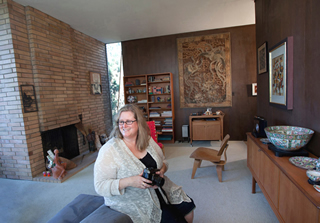City on a Hill - Page 3
 |
|
|
 |
|
|
 |
|
|
 |
|
|
A bad rental market hurt the Laguna Heights tower, sales were slow at the low-rise, Geneva Towers was still under construction, and Eichler Homes, Inc. was bleeding cash. In 1966 Eichler sold the company, and it was soon bankrupt. Eichler himself recovered, founding smaller successor companies to build more homes. But he never again built an urban complex.
The Laguna Heights low-rises were designed as a cooperative, which means buyers would own the building in common, not just their units, as in a condo. But it took a while to attract buyers, so it began as rentals until enough people moved in to form a co-op, says Damele, one of the original residents.
One of the six low-rises never became part of the co-op at all. It remained rentals, apparently as a way to generate cash for Eichler Homes. Later the building went condo.
It was a raw neighborhood when Damele and her husband, a pharmacist, moved into Laguna Heights. The tower at 66 Cleary was just beginning construction. The sprawling Japantown commercial complex, which sits across Geary Boulevard, was a dirt lot. “Everything was bare looking around here,” Damele remembers.
Both low- and high-rises attracted middle-class residents at the time—doctors, professors, merchants—mostly white and Asian. Since then, many African-Americans have moved in, and people from almost every culture.
The wood-frame Laguna low-rise buildings, three-stories over a story for parking, are lined up like soldiers. Landscaping by the firm Sasaki Walker softens things considerably, with walkways, curved benches by low fountains, and many trees.
The landscaping remains a major amenity, says Chris Flick, an interior designer who lives there. From her window she spots falcons, woodpeckers, “lots of hummingbirds,” and raccoons. “Hearing water running from fountains is special,” she says.
The three-bedroom, two-bath apartments are arrayed pinwheel style around a large central courtyard—Laguna Height’s version of the Eichler atrium. Originally the courtyards had central planters with benches surrounding a tree. Due to leakage, most have been removed. “That broke my heart,” Colleen Mullins says.
In one of the low-rise buildings, resident Linda Belden, a designer, has restored something of the original landscaping spirit, if not the exact look, by adding four large wooden planters filled with tall palm trees, along with succulents, flowering plants, and more.
“I try to keep it true to the Eichler look,” she says. “Some people wanted it to be more flowery.”
The units—12 per building, for a total of 72—have brick fireplaces, sliding glass, patios, and ribbon windows.
The low-rise development attracted some people because it was a cooperative, including Angela Little, then a UC Berkeley professor, and her husband George, who bought in 1972.
George had been president of the Berkeley Co-op, and Angela became president of the Laguna Heights Cooperative Corp. “We liked the idea of cooperation as opposed to competition,” she says. “Working for the good of the whole rather than just for myself appeals to me.”
The Eichler tower, a reinforced concrete structure with 15 floors of apartments over three of parking, has 150 apartments. Floors, ceilings, and most interior walls are concrete.
When Kathie Barr moved into the high-rise in 1965, the building was only one-third full, she remembers. She enjoyed watching the cranes at work building the rest of the neighborhood.




